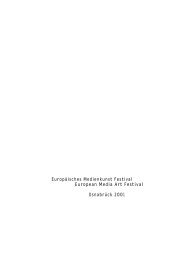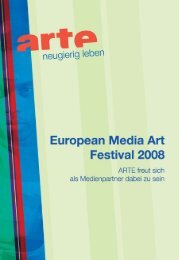Create successful ePaper yourself
Turn your PDF publications into a flip-book with our unique Google optimized e-Paper software.
BRUCE BAILLIE - THE PASSIONIST<br />
CASTRO STREET<br />
Bruce Baillie<br />
Inspiriert durch eine Lektion von Eric Satie, ein Film in der Form einer Straße - die Castro Street geht an der Standard<br />
Ölraffinerie in Richmond, Kalifornien entlang... Rangierlokomotiven an der einen Seite und Raffinerielager,<br />
Schornsteine und Gebäude auf der Anderen - die Straße und der Film enden an einer Bauholzfirma. Alle visuellen<br />
und Audioelemente von der Straße, sich weiterentwickelnd vom Beginn der Straße bis zum Ende, sind schwarzweiß<br />
(sekundär) und eines ist farbig, wie männliche und weibliche Elemente. Das Auftauchen einer langen Aufnahme<br />
eines Ölarbeiters (Schwarzweiß-Solo) ist für den Filmemacher das wesentliche Bild des Bewusstseins. - B.B.<br />
›Ich war nach dem ersten Anblick so angetan von der Schönheit des Films Castro Street von Baillie, dass ich ihn<br />
sofort noch mal sehen wollte. Die kontrastierenden Bilder (Stahl/Blumen) und Geräusche (metallisches<br />
Knirschen/Klaviergeklimper) sind erstaunlich. An der Standard Ölraffinerie in Richmond, Kalifornien gedreht, ist<br />
der Film voller strukturierter Bilder von Zügen, Metall und Maschinen. Vermischt mit Aufnahmen vom Himmel und<br />
farbenprächtigen Blumen. Eine besondere Szene handelt von den Zügen, die jetzt immer schneller werden, und mündet<br />
auf einem Feld mit atemberaubend schönen violetten Veilchen, die in einem Feld wachsen, das ein Zug von der<br />
rechten Seite her hereinrollt. Baillies Gebrauch von Schwarzweißbildern in Verbindung mit prächtigen Farbbildern<br />
und subtil strukturierten Bildern ist herrlich. Manchmal scheinen die Dinge übereinander zu gleiten und der<br />
Zuschauer erhält eine visuelle Kollage von Farben und Formen. Baillie beschreibt diesen Bildkontrast als ›männliche‹<br />
und ›weibliche‹ Aufnahmen und erklärt weiter in einem Interview mit Scott MacDonald für A Critical Cinema 2, ›Ich<br />
wollte diese uralte, universale Wahrheit des Gegensätzlichen, das Eins ist, visualisieren, sowohl im Widerstreit als<br />
auch im Einklang - sich gegenüberstehend und doch bindend.‹ Ich erwartete ungeduldig von Anfang bis Ende auf das<br />
nächste Bild. Die Einbeziehung eines populären Softrock-Titels war eine schöne Überraschung und kontrastierte wieder<br />
mal mit den Geräuschen der Motoren, Pfeifen und Maschinen.‹ Donna Albano, 2001<br />
Inspired by a lesson from Eric Satie, a film in the form of a street - Castro Street running by the Standard Oil Refinery in Richmond,<br />
California... switch engines on one side and refinery tanks, stacks and buildings on the other - the street and the film ending at a red<br />
lumber company. All visual and sound elements from the street, progressing from the beginning to the end of the street is black and white<br />
(secondary), and one is colour like male and female elements. The emergence of a long switch engineer shot (black and white solo) is to<br />
the film-maker the essential image of consciousness. - B.B.<br />
›I was so struck by the beauty of Baillie's Castro Street the first time that I saw it, that I immediately wanted to see it again. The contrasting<br />
images (steel/flowers) and sounds, (metal grinding/piano tinkling) are stunning. Shot at the Standard Oil Refinery in Richmond,<br />
California the film is full of textured images of trains, metal and machinery. Mixed in are shots of sky and vibrant flowers. One particular<br />
scene focuses on the trains which are now moving at a faster pace and opens to a field of stunningly beautiful purple violets set in a<br />
field into which another train enters the frame from the right. Baillie's use of negative black and white images in combination with<br />
vibrant color images and subtly textured images is magnificent. At times things seems to be sliding over each other, and the viewer is<br />
treated to a visual collage of color and form. Baillie describes the contrast in images as being shot in ›masculine‹ and ›feminine‹, and goes<br />
on to explain this in an interview with Scott MacDonald for A Critical Cinema 2, ›I wanted to visualize that ancient, universal fact of<br />
opposites that are one, both in conflict and harmony---opposing each other and abiding together.‹ From the beginning to the end I found<br />
myself waiting eagerly for the next image to appear. The inclusion of a popular soft rock melody was a lovely surprise and again contrasted<br />
with the sounds of the engines, whistles, and machinery.‹ Donna Albano, 2001<br />
// 1966, 16mm, b&w/color/sound, 10:00<br />
158












